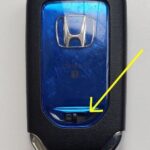Experiencing issues with your 2017 Nissan Altima key fob after a battery replacement can be frustrating. Many Nissan Altima owners encounter problems like “Invalid Key ID” messages or unresponsive key fob buttons after changing the battery. Fortunately, these common issues often have straightforward solutions you can perform yourself. This guide will walk you through troubleshooting steps and key fob programming methods specifically for your 2017 Nissan Altima, ensuring you get back on the road quickly.
Issue #1: “Invalid Key ID” or “No Key Detected” Messages After Battery Replacement
One prevalent problem after replacing your 2017 Nissan Altima key fob battery is seeing “Invalid Key ID” or “No Key Detected” warnings on your dashboard. You might also notice that the door request buttons on your vehicle no longer function. However, the remote functions on your key fob, such as locking/unlocking doors or opening the trunk, may still work. You can typically still start your Altima by pressing the start button directly with the key fob or, in some models, by inserting it into an emergency key receptacle.
Solution for Issue #1: Key Fob Re-synchronization
This issue often arises because the key fob needs to be resynchronized with your 2017 Nissan Altima after a battery change. Here’s how to perform a simple key fob re-synchronization:
- Remove the Backup Door Key: Take out the mechanical backup key from your Nissan Altima key fob.
- Enter and Position the Key Fob: Get inside your Nissan Altima, ensuring you leave the key fob inside the vehicle.
- Cycle Ignition (Without Starting Engine): Press the start button twice without pressing the brake pedal. This will cycle the ignition to the “ON” position without starting the engine.
- Exit Vehicle with Backup Key: Open the driver’s side door and step out of your Altima. Make sure to take the backup door key with you, leaving the key fob inside the car.
- Lock Door Manually: Close the driver’s side door and use the backup door key to manually lock the door by turning the key to the left in the door lock cylinder. You should hear the door locking mechanism engage.
- Unlock Door Manually: Immediately turn the key to the right in the door lock cylinder to unlock the door. Again, listen for the unlocking mechanism.
- Re-enter Vehicle and Turn Off Ignition: Open the driver’s door, get back into your Nissan Altima, and press the start button one more time (again, without pressing the brake pedal) to turn the ignition to the “OFF” mode.
After completing these steps, the “Invalid key ID” messages should disappear, and all key fob functions, including door request buttons, should be working correctly on your 2017 Nissan Altima.
Issue #2: Key Fob Buttons (Remote Lock, Panic, Trunk) Not Working After Battery Replacement
In contrast to the first issue, you might encounter a situation where everything seems normal after a 2017 Nissan Altima key fob battery replacement except for the push-button functions on the key fob itself. This means the remote door lock, panic button, remote trunk release, and remote start (if your Altima is equipped) might become unresponsive. The car will likely still start and operate normally, but the remote features are disabled.
Solution for Issue #2: ECU Reboot with Key Fob Inside
This problem often indicates that the push-button functions of your 2017 Nissan Altima key fob need to be reprogrammed to the vehicle’s ECU (Engine Control Unit). A simple ECU reboot with the key fob inside the car can often resolve this.
- Locate the Car Battery: Open the hood of your 2017 Nissan Altima and locate the main car battery.
- Disconnect Battery (Cold Boot): Using a wrench, carefully disconnect the negative terminal of your car battery. Wait for a minute or two. This “cold boot” allows the ECU to reset.
- Reconnect Battery: Reconnect the negative battery terminal securely.
- Key Fob Reprogramming (Automatic): With the key fob inside your 2017 Nissan Altima, the ECU will automatically attempt to reprogram the push-button functions during the reboot process.
Important Note: Disconnecting your car battery will reset the ECU’s learned settings. As a result, your 2017 Nissan Altima might idle or drive slightly differently for the first few miles after reconnecting the battery. This is normal, and the ECU will quickly relearn and return to its optimal settings.
General Key Fob Battery and Reprogramming Tips
- Correct Battery Type: Always use the correct replacement battery for your 2017 Nissan Altima key fob. The standard battery is a CR2032 button cell battery. While a CR2025 battery might fit and work temporarily, it is slightly thinner and has a lower capacity, meaning it won’t last as long as a CR2032.
- Reprogramming Both Key Fobs: If you have two key fobs for your 2017 Nissan Altima and are experiencing issues with both, you can attempt to reprogram both simultaneously. For either of the solutions described above, simply leave both key fobs inside the car during the reprogramming procedure. While not always necessary, this can sometimes be more efficient if both fobs are malfunctioning.
- Preventative Battery Replacement: To minimize the chances of encountering key fob programming issues, consider replacing your 2017 Nissan Altima key fob battery before it completely dies or exhibits intermittent problems. Replacing the battery while it still has some charge can often prevent memory corruption within the key fob and avoid the need for reprogramming altogether.
By following these troubleshooting steps, you can often resolve common key fob issues on your 2017 Nissan Altima after a battery replacement, saving you time and a trip to the dealership.
